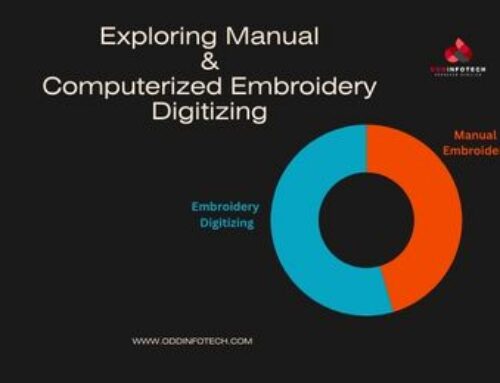What is Applique Embroidery Digitizing?
Applique embroidery digitizing is the process of converting a design or image into a digital format that can be read and interpreted by an embroidery machine. In the context of embroidery, applique refers to a technique where a fabric piece is sewn onto another fabric to create a decorative design. This technique is commonly used to add texture, color, and dimension to embroidered designs.
Digitizing is a crucial step in the embroidery process. It involves using specialized software to create a digital file that contains the instructions for the embroidery machine. This file provides information on stitch types, densities, colors, and other details necessary for the machine to recreate the design accurately.
In the case of applique embroidery digitizing, the digitizer must create a file that not only represents the overall design but also includes instructions for the machine to handle the applique elements. This may involve outlining the applique shape, defining the stitching sequence, and specifying where the fabric pieces should be attached.
The result of the digitizing process is a file that can be loaded into an embroidery machine, allowing it to stitch out the design with the applique elements precisely placed. Applique embroidery digitizing is popular in various industries, including fashion, home decor, and promotional products, where intricate and colorful designs are desired.
Significance in Contemporary Embroidery
Explore how the digitization of applique embroidery has become a vital aspect of modern embroidery, revolutionizing design possibilities and production efficiency.
Understanding Applique Embroidery
Applique embroidery is a decorative needlework technique that involves attaching pieces of fabric onto a base fabric to create intricate designs and patterns. This form of embellishment has been used for centuries to add texture, color, and dimension to various textiles. Understanding the basics of applique embroidery can open up a world of creative possibilities for individuals interested in fabric arts and crafts.
Basic Applique Embroidery Techniques
Choosing Fabrics
- Select contrasting or complementary fabrics for the applique pieces and the base fabric.
- Consider the weight and texture of the fabrics to ensure they work well together.
Preparing the Fabric
- Iron the fabrics to remove wrinkles and create a smooth surface.
- Apply fusible interfacing to the back of the applique fabric to add stability.
Creating Templates
- Draw or print the desired applique shapes onto paper or cardstock to create templates.
- Cut out the templates carefully to ensure precision in your design.
Transferring Designs
- Pin or trace the templates onto the applique fabric using chalk or water-soluble fabric markers.
Cutting Applique Pieces
- Cut the fabric along the traced lines, leaving a small seam allowance for attaching to the base fabric.
Attaching Applique
- Position the applique pieces onto the base fabric according to your design.
- Secure them with pins or use temporary fabric adhesive to hold them in place.
Stitching
- Choose a suitable embroidery stitch to attach the applique pieces to the base fabric.
- Common stitches include satin stitch, blanket stitch, or a straight stitch close to the edges.
Benefits of Applique Embroidery Digitizing
Precision in Design
Highlight the precision achieved through digital techniques, ensuring accurate replication of intricate designs.
Customization and Personalization
Discuss the flexibility digital applique embroidery offers for customization, allowing designers to tailor projects to specific needs.
Time and Cost Efficiency
Examine how digitization contributes to time and cost savings in the embroidery process.
Getting Started
Essential Tools and Software
Provide an overview of the necessary tools and software required for successful applique digitizing.
Choosing the Right Fabric for Applique
Guide on selecting suitable fabrics for applique projects, considering texture, thickness, and compatibility.
Step-by-Step Applique Embroidery Digitizing Process
Applique embroidery digitizing is the process of converting a design into a digital format that can be read by an embroidery machine. Here is a step-by-step guide for creating applique embroidery designs:
Design Concept
Start with a clear idea of the design you want to create. Applique embroidery involves stitching a fabric piece onto the base fabric, so consider the shapes and layers involved in your design.
Digitizing Software
Use specialized embroidery digitizing software such as Wilcom, Embird, or Hatch. These programs are designed to create embroidery files compatible with various embroidery machines.
Import Design
Import the design file or create a new one in the digitizing software. Most digitizing software allows you to import various file formats like SVG, AI, or BMP.
Convert to Applique
Identify the areas of the design where you want to add applique. These areas will be stitched over with fabric rather than thread. Use the applique tool in the software to define these sections.
Create Placement Stitch
Generate a placement stitch for each applique section. This stitch will show the machine where to place the fabric. It’s usually a simple outline of the applique shape.
Add Tack Down Stitch
Include a tack down stitch that secures the fabric in place. This stitch is often a running stitch around the placement stitch, holding the fabric in position.
Trimming Line
Insert a trimming line or tack down stitch to mark where the excess fabric should be cut away. This helps in achieving clean edges on the applique.
Cutting Fabric
After the machine stitches the placement and tack down stitches, manually place the fabric over the stitched area. Trim the excess fabric along the trimming line using scissors or a rotary cutter.
Finish the Design
Continue digitizing the rest of the design, adding any additional details or text. Adjust stitch settings, density, and underlay to ensure the final embroidery is of high quality.
Save the File
Save the completed embroidery design file in the format compatible with your embroidery machine. Common formats include DST, PES, or EXP.
Test Run
Before stitching on the final garment or fabric, run a test on a piece of scrap fabric to ensure the design looks as expected and that the applique is properly secured.
Machine Embroidery
Load the digitized file into your embroidery machine. Follow the machine’s instructions for thread colors and other settings. Secure the fabric to the machine’s hoop and start the embroidery process.
Best Practices for Applique Digitizing
Optimizing Stitch Density
Explore techniques for optimizing stitch density to achieve the desired texture and appearance.
Managing Thread Tension
Provide insights into effectively managing thread tension for consistent and high-quality embroidery.
Handling Complex Designs
Tips and tricks for successfully digitizing and embroidering intricate and complex applique designs.
Challenges and Solutions
Dealing with Small Details
Address challenges associated with small details in applique designs and propose effective solutions.
Addressing Stitching Errors
Troubleshoot common stitching errors encountered during the embroidery process.
Handling Different Fabrics
Guidance on overcoming challenges posed by different fabrics during the digitizing and embroidery stages.
Advanced Techniques in Applique Digitizing
3D Applique Embroidery
Explore advanced techniques, such as 3D applique embroidery, adding depth and dimension to designs.
Multi-Layered Designs
Discuss the process of creating multi-layered applique designs for enhanced visual impact.
Incorporating Texture Digitally
Examine methods for incorporating digital textures into applique designs for a tactile effect.
Industry Applications
Fashion and Apparel
Highlight the role of digital applique in the fashion and apparel industry, showcasing examples and trends.
Home Decor and Textiles
Explore how applique digitizing contributes to home decor and textile applications, with real-world examples.
Corporate Branding and Logos
Discuss the use of digital applique in corporate branding and logo design.
Trends in Applique Embroidery Digitizing
Emerging Technologies
Explore the latest technologies shaping the future of applique embroidery digitizing.
Innovative Design Trends
Highlight current and emerging design trends in the world of digital applique embroidery.
Sustainability in Applique Digitizing
Eco-Friendly Materials and Practices
Discuss sustainable and eco-friendly approaches to materials and practices in the applique digitizing process.
Long-Term Viability of Digital Applique
Consider the long-term environmental impact and viability of digital applique techniques.
Legal Considerations
Copyright and Intellectual Property
Address legal considerations related to copyright and intellectual property in the digitized applique industry.
Licensing for Commercial Use
Guide on obtaining and managing licenses for commercial use of digitized applique designs.
Quality Control in Applique Embroidery
Testing and Prototyping
Discuss the importance of testing and prototyping in ensuring the quality of digitized applique designs.
Ensuring Consistency in Production
Explore strategies for maintaining consistency in production for large-scale applique embroidery projects.
Future of Applique Embroidery Digitizing
Anticipated Technological Advancements
Predict future technological advancements that may influence the field of applique embroidery digitizing.
Potential Market Growth
Examine potential market growth and opportunities in the evolving landscape of digital applique embroidery.
FAQs
Q1: What is Applique Embroidery Digitizing?
A1: Applique embroidery digitizing is the process of converting a design into a digital format that can be read by embroidery machines. In the context of applique, it involves creating a digital file that guides the machine to stitch a design with fabric pieces layered on the base material.
Q2: What makes Applique Digitizing different from regular embroidery digitizing?
A2: Unlike regular embroidery digitizing, applique digitizing focuses on incorporating fabric elements into the design. This process involves creating paths for the machine to stitch around fabric pieces, allowing for a more textured and dimensional finished product.
Q3: What types of fabrics are suitable for applique embroidery?
A3: Various fabrics can be used for applique, including cotton, felt, denim, and more. It’s essential to choose fabrics that are compatible with the embroidery machine and can withstand the stitching process.
Q4: Can any design be turned into an applique embroidery design?
A4: In theory, yes. However, some designs are better suited for applique than others. Designs with distinct sections or areas that can be filled with fabric work well. Simple, bold designs with clear outlines tend to produce the best results.
Q5: What file formats are compatible with embroidery machines for applique?
A5: Commonly used file formats for embroidery machines include .dst, .pes, .exp, and .jef. It’s essential to check the specifications of your embroidery machine and software to ensure compatibility.
Q6: Do I need special software for applique embroidery digitizing?
A6: Yes, specialized embroidery digitizing software is necessary for creating applique designs. Software like Wilcom, Pulse, or Hatch Embroidery provides tools and features tailored to the unique requirements of applique digitizing.
Q7: Are there specific techniques for optimizing applique embroidery digitizing for different fabrics?
A7: Yes, optimizing for different fabrics involves adjusting stitch density, underlay stitching, and other settings in the digitizing software. Experimentation and testing on scraps of the actual fabric are recommended to achieve the best results.
Q8: Can applique embroidery be done on different garment types?
A8: Absolutely! Applique embroidery is versatile and can be applied to various garments, including T-shirts, jackets, hats, and more. The key is to ensure that the fabric and design are compatible with the chosen garment.
Q9: How do I troubleshoot common issues in applique embroidery digitizing?
A9: Issues like puckering, misalignment, or thread breaks may arise. Troubleshooting involves adjusting tension settings, optimizing stitch parameters, and making sure the fabric is properly stabilized. Regular maintenance of the embroidery machine is also crucial.
Q10: Are there online resources or communities for learning more about applique embroidery digitizing?
A10: Yes, there are many online forums, tutorials, and communities where enthusiasts and professionals share tips and techniques. Websites like EmbroideryDesigns.com, Embroidery Library, and forums like Machine Embroidery Geek are excellent starting points for learning and sharing experiences.
Conclusion
In conclusion, the journey through “The Ultimate Guide to Applique Embroidery Digitizing Magic” has been an illuminating exploration into the artistry and technical intricacies of appliqué embroidery digitizing. We’ve delved into the transformative power of turning creative visions into digital stitches, unlocking a realm of possibilities for designers and enthusiasts alike.
From understanding the fundamentals of appliqué embroidery to mastering the intricacies of digitizing techniques, this guide has aimed to demystify the magic behind bringing fabric to life with intricate patterns and textures. The fusion of traditional craftsmanship with modern technology showcased in the digitizing process exemplifies the evolving landscape of embroidery.
As we close this comprehensive guide, we hope it serves as a beacon for those venturing into the realm of appliqué embroidery digitizing. May the knowledge imparted here empower your creative endeavors, allowing you to transcend the boundaries of conventional embroidery and embrace the limitless potential that digitization offers.
Embark on your digital embroidery journey with confidence, armed with the insights and skills acquired from this guide. Whether you are a seasoned professional or a passionate hobbyist, may the magic of appliqué embroidery digitizing continue to inspire and elevate your craft, turning every stitch into a masterpiece.







Stop by my blog post: майка с надписью